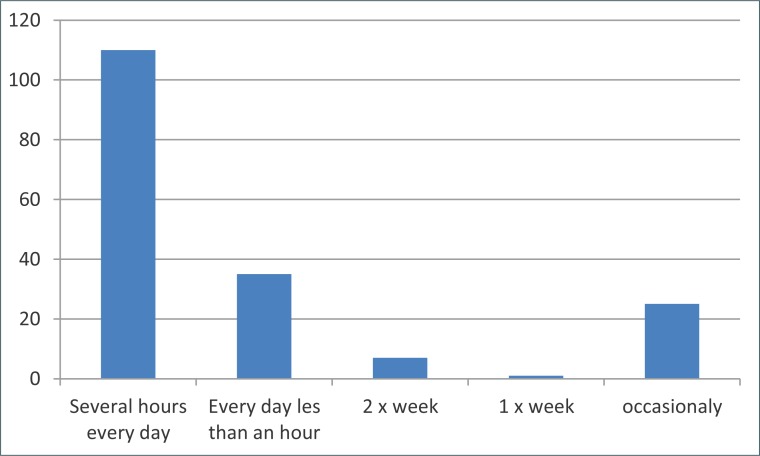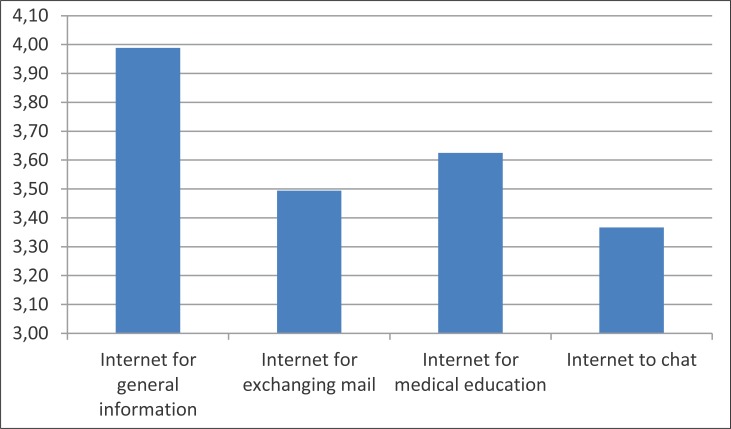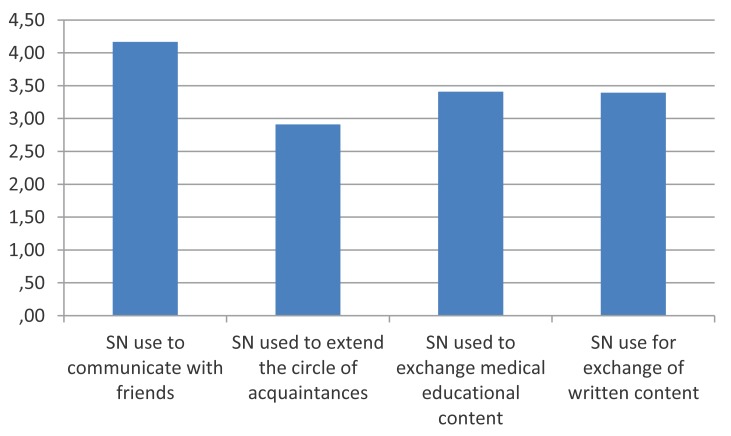Abstract
Introduction:
Beginning with the late twentieth and early twenty-first century, the Internet was a significant additional tool in the education of teenagers. Later, it takes more and more significant role in educating students and professionals.
Goal:
The aim of this paper is to investigate, to what extent and how effectively the Internet is used today by students of biomedical faculties in Bosnia and Herzegovina. In addition, more specifically, this paper will research the implications of the well-known social networks in education of students and health professionals in Bosnia and Herzegovina. We compared the ratio of using Social networks by students for spreading medical information as basics for health education at medical faculties at 3 universities in Bosnia and Herzegovina (B&H).
Results and discussion:
The results showed that only 11.6% of professors use Facebook type of social network, 49.3% of them have a profile on BiomedExperts scientific social network and 79% have available articles in the largest biomedical literature database MEDLINE. Students are also frequent users of general social networks and educational clips from You Tube, which they prefer to utilize considerably more than the other types of professionals. Students rarely use the facilities of professional social networks, because they contain mainly data and information needed for further, postgraduate professional education.
Conclusion:
In B&H there are decent conditions for the use of online social networks in the education of health professionals. While students enthusiastically embraced these opportunities, this is not so much a case with health care professionals in practice; while scientific health care workers have not shown greater interest in the use of social networks, both for purposes of scientific research and in terms of self-education and training of students.
Key words: Social networks, education, health professionals, students, Bosnia and Herzegovina.
1. INTRODUCTION
Social network is a social structure made up of individuals and organizations that represent “nodes”, and they are associated with one or more types of interdependency, such as: friendship, common interests, work, knowledge, prestige and many other interests (1, 2, 3). Development of modern information and telecommunication technologies has enabled large social networking capabilities (1). Members of the network no longer have to be in a physical contact; they may be on another continent and can exchange information, at any time of day (4).
Such Internet possibilities are used in different ways, during the undergraduate and postgraduate education of health workers and continuing health education (1, 3). At undergraduate level, the students often use global social networks (i.e. Facebook, Twitter, You Tube ...) or some specific health social networks, such as various forums with health issues (e.g. Health Care Forum). They rarely use the health science social networking (Medline, WoS, Scopus, BioMedExperts, WebMD...), as opposed to other professionals in medical education (1). In the undergraduate studies, the exchanged information is usually needed for the education, training and the acquisition of certain skills. Often, these elements represent non-critical information, which is sometimes inappropriately labeled as, ethics and deontology of health care workers (4). In a graduate study, the usually exchanged scientific information is used to advance the cooperation in the scientific research projects.
2. THE AIM OF THE RESEARCH
The aim of this paper is to investigate, to what extent and how effectively, the Internet is used. The special emphasis is given to the well-known social networks in the education of students and health professionals in B&H.
3. RESEARCH METHOD
The research was conducted by surveying 200 students of the Health Faculty of the University of Zenica, the Faculty of Medicine, University of Sarajevo and 210 health professionals (i.e. doctors and medical technicians) in Zenica Doboj Canton. The criteria by which the students were sorted were first three and second three study years.
4. RESULTS
From 180 respondents 88.8% of them have Internet access and they all have a profile on the social networks (mostly on Facebook 86.6%). Pearson correlation between the purpose of using social networks and the average score on the faculty. (Table 1, 2, 3) The correlation is extremely positive for the use intended to expand the circle of acquaintances and exchange of educational and written content. Without statistically significant relationship between the purpose of using social networks and average grades. Pearson correlation between the purpose of internet use shows a pronounced relationship between use to exchange mail and chat with use for medical education. There is also no statistically significant relationship between success (average grade) and the purpose of internet use. (Graph 1, 2, 3).
Table 1.
Correlation beetwen different users of social networks
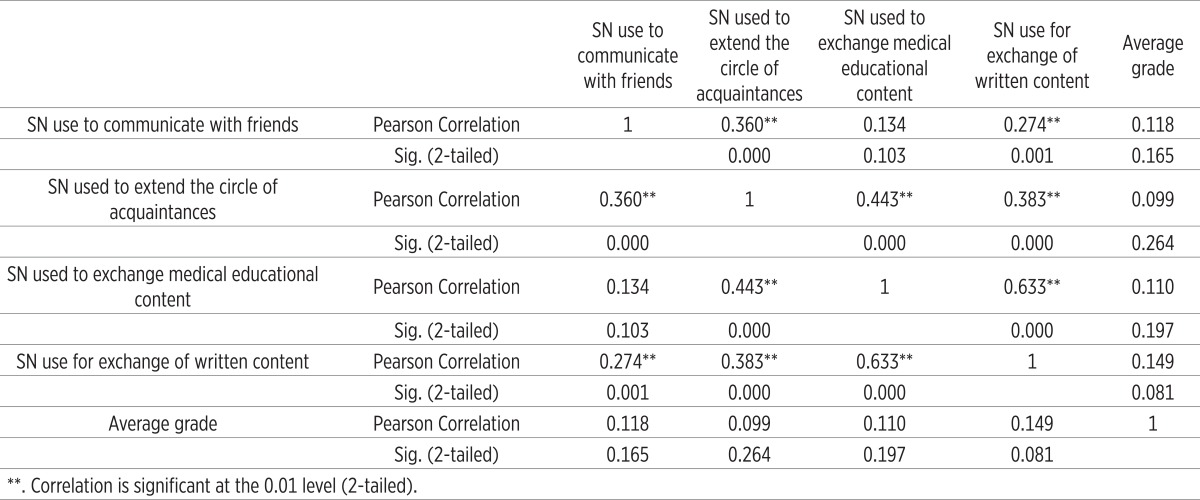 |
Table 2.
The ratio of purposes of using social networks by students
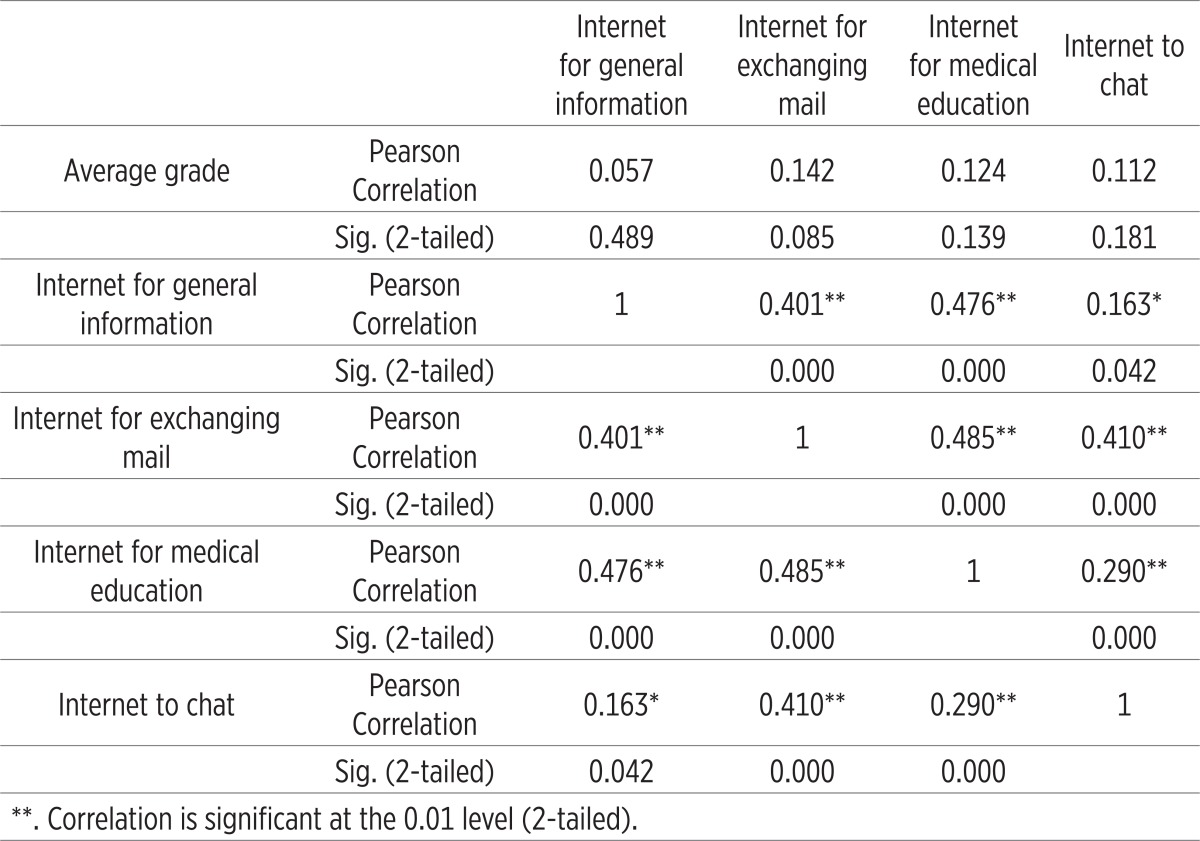 |
Table 3.
The ratio of internet users by gender
 |
Graph 1.
Frequency of Internet use by students of the biomedical orientation.
Graph 2.
The purpose of using the internet (on a scale of 1 to 5, where 1 is the worst score and 5 the most favorable.
Graph 3.
The purpose of using social networks (on a scale of 1 to 5, where 1 is least and 5 most common).
Besting the average grade in relation to access the Internet by Student t test, we get that t = 0.462 for which p> 0.05 and conclude that there was no statistically significant differences in the average grade and the use of the Internet.
5. DISCUSSION
Public social networks, based on Internet, enable communication, collaboration and information gathering in the field of health care. More than half (55%) of Americans who are investigating health problems in the Internet age, research the data about the therapy or condition via the Internet, while, a third of them use social networks. About 60% of doctors in the U.S.A. use social networks for professional purposes (1). To a large extent, social networks can be used in undergraduate and graduate education of health professionals.
Students were also frequent users of general social networks, and educational clips from You Tube, considerably more than other professionals. That fact actually determined the possible data and information that they exchange (1). Usually, the exchanged content was related to a process of mastering of certain skills necessary to a graduate education. However, there were no critical reviews of the content, that was often found to be unprofessional and unethical, on the general social networks like Facebook, Twitter and You Tube (4). Students rarely used the facilities of professional social networks, because they mainly contained data and information needed for further, graduate and/or professional education. Unlike the use of professional social networks, students often use illegal educational material on the site that offers it (e.g. warez and other portals). In that way, they get the reference literature, but harm the authors by disrespecting copyrights. Health professionals often use the professional social networking. There are either, looking for, or are sharing the reference information they need in practice, or are using it for a further professional advancement. It is also important to note that they also use the general social networks, but considerably less than the students. There is no serious use of general social networks there, although they provide a significant on opportunities, from education to the creation of the health policy (1). Social networks, especially scientific social expert’s network provide significant opportunities to researchers, scholars and professors at medical faculties and universities. Although the scientists are, by nature, not inclined to a social interaction, and they usually, rather hide in their labs trying to find some next great discovery, there are numerous scientific social networks. Some of them are specific to the biomedical sciences and the most famous, among them is BioMedExperts. BioMedExperts is an online community of biomedical scientists, which shows the essential features related to their work and it cooperates on projects and areas of interest. It is these characteristics that are of great help to analyze the use of social networks by biomedical scientists, with four medical schools in B&H, and their comparison with a group of eminent scientists from our region who are now working around the world. The study group included 151 part-time and regular teachers. We have sought the Facebook profiles of teachers and found that only 14.6% of domestic scientists use Facebook, while this percentage is significantly higher for those who work outside of B&H (54.5%). Profiles of scientific workers in B&H are generally not public and they are only available to the certain members of the network. They do not use them for training or are present in groups dealing with a specific health issues on Facebook, as opposed to a group of scientists who work outside of B&H.
By taking the opportunities given by the social networks we also have to mention that publishing of private data (i.e. personal information, hobbies, pictures, etc.) is always bound to a significant loss of privacy and can lead to unwanted personal disadvantages. These can arise when social network providers are confronted with security related issues and cyber criminals steal private data. Social networks also provide the best source for human resources managers when investigating the habits of job candidates. Business models of social networks often include commercial use of user data and due to possibility of automatic analysis a huge number of potential customers can be identified easily. Generally we can say that users can never be sure who is having access to their private data and do not know what third parties have received their data from the social network providers.
6. CONCLUSION
In B&H there are decent conditions for the use of online social networks in the education of health professionals. While students are enthusiastically embracing these opportunities, they are somewhat less embraced by the health care professionals in practice. Scientific health care workers have not shown greater interest in the use of social networks, both for purposes of scientific research and in terms of self-education and training of students. Unlike these scholars, the scholars with similar “background” working outside the B&H use much more the advantages offered by the online social networks, both in education and in support of the scientific research.
CONFLICT OF INTEREST
None declared.
REFERENCES
- 1.Masic I, Sivic S, Toromanovic S, Borojevic T, Pandza H. Social Networks in Improvement of Health Care. Mat Soc Med. 2012;24(1):48–53. doi: 10.5455/msm.2012.24.48-53. doi: 10.5455/msm.2012.24.48-53. [DOI] [PMC free article] [PubMed] [Google Scholar]
- 2.Masic I, Sivic S. Social Networks in Education of Health Professionals in B&H - the Role of PubMed/Medline in Improvement of Medical Sciences. Acta Inform Med. 2011;19(4):196–202. doi: 10.5455/aim.2011.19.196-202. doi: 10.5455/aim.2011.19.196-202. [DOI] [PMC free article] [PubMed] [Google Scholar]
- 3.Thompson LA, Black E, Duff WP, Paradise Black N, Saliba H, Dawson K. Protected health information on social networking sites: ethical and legal considerations. J Med Internet Res. 2011 Jan 19;13(1):e8. doi: 10.2196/jmir.1590. [DOI] [PMC free article] [PubMed] [Google Scholar]
- 4.Petrovic D. From Social Networks to Network Society: A Review of the Macro Network Approach in Sociology. Sociologija. 2007;49(2):161–182. [Google Scholar]



